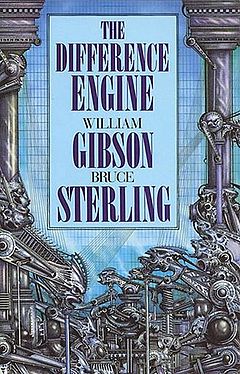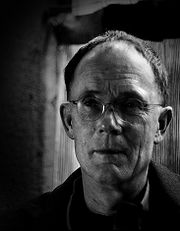- The Difference Engine
-
For the machine designed by Charles Babbage, see Difference engine.
The Difference Engine 
Cover of first edition (hardcover)Author(s) William Gibson and Bruce Sterling Language English Genre(s) Alternate history, steampunk Publisher Victor Gollancz Ltd Publication date September 1990 Media type Print (hardback and paperback) Pages 256 pp ISBN 0-575-04762-3 OCLC Number 21299781 The Difference Engine is an alternate history novel by William Gibson and Bruce Sterling.
It posits a Victorian Britain in which great technological and social change has occurred after entrepreneurial inventor Charles Babbage succeeded in his ambition to build a mechanical computer (actually his analytical engine rather than the difference engine).
The novel was nominated for the British Science Fiction Award in 1990, the Nebula Award for Best Novel in 1991, and both the John W. Campbell Memorial Award and the Prix Aurora Award in 1992.
Contents
Setting
The novel is chiefly set in 1855. The historical background diverges from reality around 1824, when it is imagined that Charles Babbage succeeded with his Difference Engine and went on to develop the Analytical Engine. He became politically powerful and at the 1830 general election opposed the Tory Government of the Duke of Wellington. Wellington staged a coup d'etat in 1830 in an attempt to overturn his defeat and prevent the acceleration of technological change and social upheaval, but was assassinated in 1831. So the Industrial Radical Party, led by a Lord Byron who had not died in the Greek War of Independence, came to power. The Tory Party and hereditary peerage were eclipsed. British trade unions assisted the ascendancy of the Industrial Radical Party (much as they aided the Labour Party of Great Britain in the twentieth century in our own world). As a result, Luddite anti-technological working class revolutionaries were ruthlessly suppressed.
By 1855 the Babbage computers have become mass-produced and ubiquitous, and their use emulates the innovations which actually occurred during our information technology and Internet revolutions. Other steam powered technologies have also developed, so, for example, Gurney steam carriages are an increasingly common sight. The novel explores the social consequences of an information technology revolution in the nineteenth century, such as the emergence of "clackers" (a reference to hackers), technologically proficient people, such as Théophile Gautier, who are skilled at programming the Engines through the use of punch-cards.
In the novel, the British Empire is more powerful than in reality, thanks to the development and use of extremely advanced steam driven technology in industry. In addition, similar military technology has enhanced the capabilities of the armed forces (airships, dreadnoughts, and artillery); and the Babbage computers themselves. Under the Industrial Radical Party, Britain shows the utmost respect for leading scientific and industrial figures such as Isambard Kingdom Brunel and Charles Darwin. Indeed, they are collectively called "savants" and often raised to the peerage on their merits, causing a break with the past as regards social prestige and class distinction. These new patterns are also reflected in the educational sphere: classical studies have lost importance compared to more practical concerns such as engineering and accountancy.
Britain, rather than the United States, opened Japan to Western trade, in part because the United States became fragmented, due to interference from a Britain which foresaw the implications of a unified United States on the world stage. Counterpart successor states to our world's United States include: a (truncated) United States; the Confederate States of America; the Republic of Texas; the Republic of California; a Communist Manhattan Island commune (with Karl Marx as a leading light); British North America (analogous to Canada, albeit slightly larger in this world); Russian America (Alaska); and terra nullius. Napoleon III's French Empire holds an entente with the British and Napoleon is even married to a British woman. In the world of The Difference Engine, it occupies Mexico. Like Great Britain, it has its own analytical/difference engines (ordinateurs), especially used in the context of domestic surveillance within its police force and intelligence agencies. As for the other world powers, Germany remains fragmented, with no suggestion that Prussia will eventually form the core of a unified nation as it did in our own world in 1871, which may be due to French sabotage analogous to that pursued in the case of the fragmentation of the United States noted above. As noted above, Japan is awakening after the British ended its isolation, and looks set to become one of this world's leading industrial and economic powers from the twentieth century onward, as in our world. Due to Lords Byron and Babbage's intervention, the Irish potato famine never occurred, and as a result there is no mention of agitation for Irish home rule or Irish independence.
Among other historical characters, the novel features "Texian" President Sam Houston, as an exile after a political coup in Texas, a reference to Percy Bysshe Shelley (as a Luddite), John Keats as a kinotropist (an operator of mechanical pixelated screens), and Benjamin Disraeli as a publicist and tabloid writer..
Plot summary
The action of the story follows Sybil Gerard, a political courtesan and daughter of an executed Luddite leader (she is borrowed from Disraeli's novel Sybil); Edward "Leviathan" Mallory, a paleontologist and explorer; and Laurence Oliphant, a historical figure with a real career, as portrayed in the book, as a travel writer whose work was a cover for espionage activities "undertaken in the service of Her Majesty".[1] Linking all their stories is the trail of a mysterious set of reportedly very powerful computer punch cards and the individuals fighting to obtain them; as is the case with special objects in several novels by Gibson, the punch cards are to some extent a MacGuffin.
During the story, many characters come to believe that the punch cards are a gambling "modus", a programme that would allow the user to place consistently winning bets. This is in line with Ada Lovelace's historically documented penchant for gambling. Only in the last chapter is it revealed that the punched cards represent a program which proves two theorems which in reality would not be discovered until 1931 by Kurt Gödel. Lovelace delivers a lecture on the subject in France.
Defending the cards, Mallory gathers his brothers and Ebenezer Fraser – a secret police officer – to fight the revolutionary Captain Swing who leads a London riot during "the Stink", a major episode of pollution in which London swelters under an inversion layer (comparable to the London Smog of December 1952).
After the abortive uprising, Oliphant and Sybil Gerard meet at a cafe in Paris. Oliphant informs her that he is aware of her true identity, but will not pursue it, although he does want information that would compromise her seducer, Charles Egremont MP, now regarded as an obstacle to the strategies and political ambitions of Lords Brunel and Babbage. Sybil has longed for an opportunity for vengeance against Egremont, and the resultant political scandal destroys his parliamentary career and aspirations for a merit lordship. Oliphant also encounters a Manhattan-based group of feminist pantomime artists.
After several vignettes that elaborate on the alternate historical origins of the world of The Difference Engine, Ada Lovelace delivers her lecture on Gödel's Theorem, as its counterpart is known in our world. She is chaperoned by Fraser, and castigated by Sybil Gerard, who is still unable to forgive Ada's father, the late Lord Byron, for his role in her own father's death.
At the very end of the novel, there is a dystopian depiction of an alternate 1991 from the vantage point of Ada Lovelace. Throughout the novel's latter sections, there are references to an "Eye". At the end of the novel, human beings appear to have become digitized, ephemeral ciphers at the mercy of a sentient artificial intelligence.
Characters
- The character Michael Godwin was named after attorney Mike Godwin as thanks for his technical assistance in linking Sterling and Gibson's computers to allow them to collaborate between Austin and Vancouver.[2]
Literary criticism and significance
The novel has attracted the attention of scholars, including Jay Clayton, who explores the book's attitude toward hacking, as well as its treatment of Babbage and Ada Lovelace;[3] Herbert Sussman, who demonstrates how the book rewrites Benjamin Disraeli's novel Sybil;[4] and Brian McHale, who relates it to the postmodern interest in finding a "new way of 'doing' history in fiction."[5]
The novel was nominated for the British Science Fiction Award in 1990,[6] the Nebula Award for Best Novel in 1991,[7] and both the John W. Campbell Memorial Award and the Prix Aurora Award in 1992.[8]
References
- ^ '"Secret Agent", Chap. 5, 'Laurence Oliphant, Anne Taylor, Oxford University Press, 1982
- ^ Sterling, Bruce. The Hacker Crackdown: Law and Disorder on the Electronic Frontier, 1992; download link from Project Gutenberg
- ^ Clayton, Jay, Charles Dickens in Cyberspace: The Afterlife of the Nineteenth Century in Postmodern Culture, Oxford University Press (2003), pp. 105-18
- ^ Sussman, Herbert (1994). "Cyberpunk Meets Charles Babbage". Victorian Studies 38: 1–23.
- ^ McHale, Brian (1992). "Difference Engine". ANQ 5: 220–23.
- ^ "1990 Award Winners & Nominees". Worlds Without End. http://www.worldswithoutend.com/books_year_index.asp?year=1990. Retrieved 2009-07-17.
- ^ "1991 Award Winners & Nominees". Worlds Without End. http://www.worldswithoutend.com/books_year_index.asp?year=1991. Retrieved 2009-07-17.
- ^ "1992 Award Winners & Nominees". Worlds Without End. http://www.worldswithoutend.com/books_year_index.asp?year=1992. Retrieved 2009-07-16.
External links
- The Difference Dictionary, an indexed addendum of topics discussed in the novel, compiled by Eileen Gunn
- Editions of The Difference Engine at Worldcat.org
- The Difference Engine at Worlds Without End
- Review at Infinity-plus
- "Gibson and Sterling's Alternative History: The Difference Engine as Radical Rewriting of Disraeli's Sybil"
William Gibson List of works · List of awards and nominationsNovels Bigend booksOtherThe Difference Engine (with Bruce Sterling)
Short stories "Fragments of a Hologram Rose" · "Johnny Mnemonic" · "The Gernsback Continuum" · "Hinterlands" · "New Rose Hotel" · "The Belonging Kind" · "Burning Chrome" · "Red Star, Winter Orbit" · "The Winter Market" · "Dogfight" · "Skinner's Room" · Burning Chrome collectionNonfiction Characters Tessier-Ashpool · Molly Millions · Bobby Newmark · Rei Toei · Konrad · Cayce Pollard · Hubertus BigendStory elements Derivative works Categories:- 1990 novels
- British alternate history novels
- British steampunk novels
- Charles Babbage
- Literary collaborations
- Novels set in London
- Novels by Bruce Sterling
- Novels by William Gibson
- 1855 in fiction
Wikimedia Foundation. 2010.
